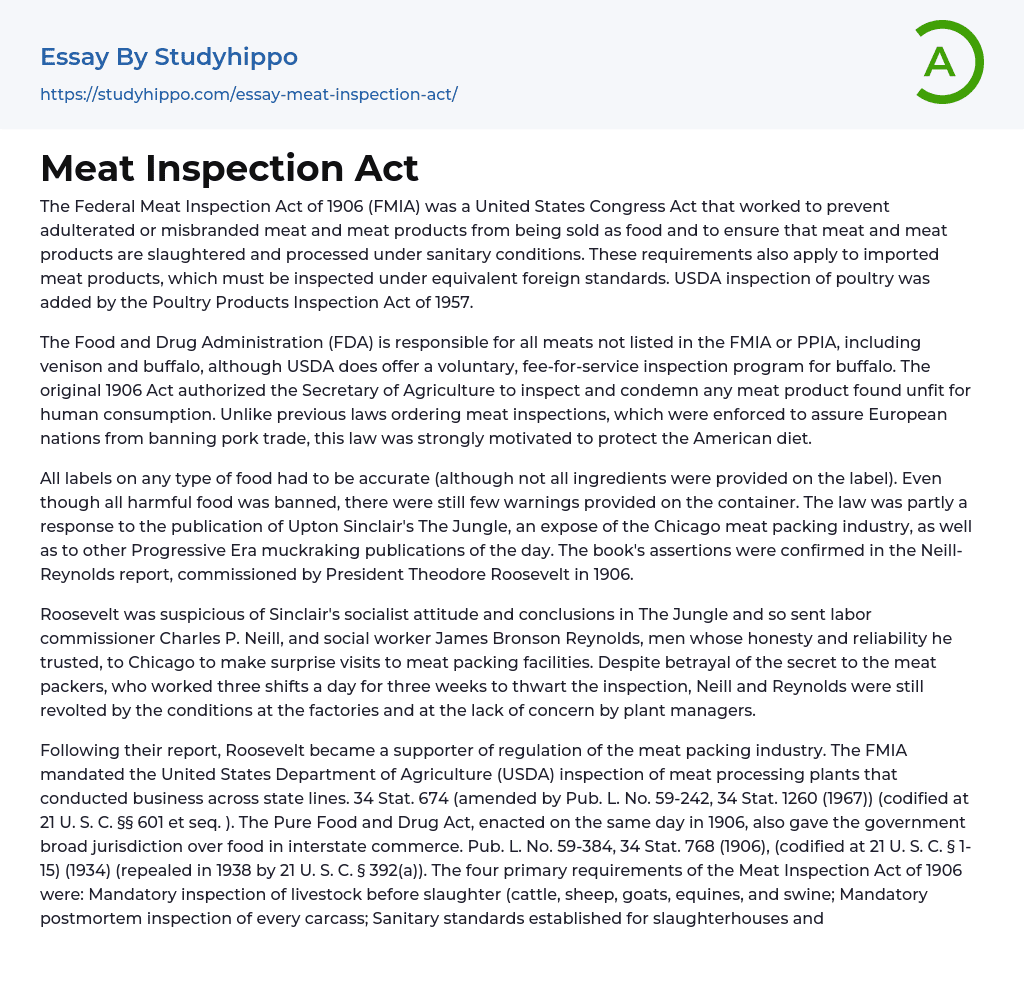The Federal Meat Inspection Act of 1906 (FMIA) was a United States Congress Act that worked to prevent adulterated or misbranded meat and meat products from being sold as food and to ensure that meat and meat products are slaughtered and processed under sanitary conditions. These requirements also apply to imported meat products, which must be inspected under equivalent foreign standards. USDA inspection of poultry was added by the Poultry Products Inspection Act of 1957.
The Food and Drug Administration (FDA) is responsible for all meats not listed in the FMIA or PPIA, including venison and buffalo, although USDA does offer a voluntary, fee-for-service inspection program for buffalo. The original 1906 Act authorized the Secretary of Agriculture to inspect and condemn any meat product found unfit for human consumption. Unlike previous laws ordering meat inspections, which were enf
...orced to assure European nations from banning pork trade, this law was strongly motivated to protect the American diet.
All labels on any type of food had to be accurate (although not all ingredients were provided on the label). Even though all harmful food was banned, there were still few warnings provided on the container. The law was partly a response to the publication of Upton Sinclair's The Jungle, an expose of the Chicago meat packing industry, as well as to other Progressive Era muckraking publications of the day. The book's assertions were confirmed in the Neill-Reynolds report, commissioned by President Theodore Roosevelt in 1906.
Roosevelt was suspicious of Sinclair's socialist attitude and conclusions in The Jungle and so sent labor commissioner Charles P. Neill, and social worker James Bronson Reynolds, men whose honesty and reliability he trusted, to Chicago to
make surprise visits to meat packing facilities. Despite betrayal of the secret to the meat packers, who worked three shifts a day for three weeks to thwart the inspection, Neill and Reynolds were still revolted by the conditions at the factories and at the lack of concern by plant managers.
Following their report, Roosevelt became a supporter of regulation of the meat packing industry. The FMIA mandated the United States Department of Agriculture (USDA) inspection of meat processing plants that conducted business across state lines. 34 Stat. 674 (amended by Pub. L. No. 59-242, 34 Stat. 1260 (1967)) (codified at 21 U. S. C. §§ 601 et seq. ). The Pure Food and Drug Act, enacted on the same day in 1906, also gave the government broad jurisdiction over food in interstate commerce. Pub. L. No. 59-384, 34 Stat. 768 (1906), (codified at 21 U. S. C. § 1-15) (1934) (repealed in 1938 by 21 U. S. C. § 392(a)). The four primary requirements of the Meat Inspection Act of 1906 were: Mandatory inspection of livestock before slaughter (cattle, sheep, goats, equines, and swine; Mandatory postmortem inspection of every carcass; Sanitary standards established for slaughterhouses and meat processing plants; and Authorized U. S. Department of Agriculture ongoing monitoring and inspection of slaughter and processing operations. After 1906, many additional laws that further standardized the meat industry and its inspection were passed.
- Food essays
- Genetically Modified Organisms essays
- Child Development essays
- Eating essays
- Breakfast essays
- Genetically Modified Food essays
- Milk essays
- Chewing gum essays
- Energy Drink essays
- Caffeine essays
- Chocolate essays
- vegetarian essays
- Weight Loss essays
- Anorexia essays
- Metabolism essays
- Diet essays
- Vitamin essays
- Dieting essays
- Junk Food essays
- Eating Habits essays
- Food Safety essays
- Food Security essays
- Beverages essays
- Cuisines essays
- Dairy essays
- Desserts essays
- Fast Food essays
- Bread essays
- Meal essays
- Meat essays
- Organic Food essays
- Rice essays
- Sugar essays
- Taste essays
- Beef essays
- Coconut essays
- Crowd essays
- Dinner essays
- Juice essays
- Sainsbury essays
- Cooking essays
- Ginger essays
- Oreo essays
- Drink essays
- Beer essays
- Wine essays
- Coffee essays
- Tea essays
- Cake essays
- Hamburger essays




